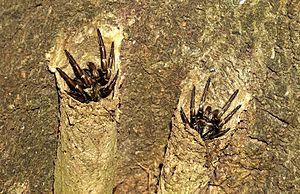Arbanitis robertsi facts for kids
Quick facts for kids Arbanitis robertsi |
|
|---|---|
 |
|
| near Gerringong, Australia | |
| Scientific classification | |
| Synonyms | |
|
Arbanitis robertsi is a type of spider known as a tube spider. It belongs to the Idiopidae family. You can find these spiders in and around rainforests in New South Wales and Queensland, Australia. This spider is medium to large in size. It builds a special tube made of web that sticks out from its underground home. These tubes are often attached to rocks, tree ferns, or the bottom of trees. In November 1922, a person named Sid Jackson saw thousands of these tubes near Wallis Lake. He described them as being "up to three feet long, and half an inch wide." They were found on damp ground, close to freshwater streams.
Contents
What Does Arbanitis robertsi Look Like?
Female Arbanitis robertsi spiders are about 27 millimeters (just over an inch) long. Males are smaller, at about 17 millimeters. Male spiders are usually a darker brown color and have longer legs than the females.
Their Amazing Burrows and Tubes
The spider's underground home, called a burrow, is usually straight or slightly slanted. It does not have a special side tunnel for eggs. The burrow goes about 30 centimeters (about a foot) deep into the ground. The web tube that sticks out above ground is usually 15 to 20 centimeters (6 to 8 inches) tall. This tube is only loosely connected to the burrow at ground level. If something pulls the tube, it breaks off above ground. This keeps the spider safe inside its underground burrow.
Living in Spider Colonies
Sometimes, tube spiders live together in groups. Their tubes can even connect to each other. When many tubes are joined, they can look a bit like organ pipes. The spiders are very good at hiding their tubes. They cover them with bits of earth, moss, and lichen. This helps the tubes blend in with their surroundings.
How They Catch Food
The spider feels vibrations on its tube when insects crawl on it. This tells the spider that potential food is nearby. The spider then catches its prey right at the opening of the tube. Their diet includes moths, beetles, and other crawling insects.
Spider Eggs and Babies
The female spider creates an egg sac inside her burrow. This sac is about 24 millimeters long and 15 millimeters wide. It is shaped like a rectangle and made of white silk. The female keeps the egg sac safe within her burrow. Each egg sac holds about 50 eggs. These eggs are a golden yellow color and are not sticky.

